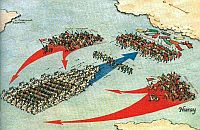Wikipedia
R.H. Allen:
Star Names
Ian Ridpath:
Star Tales
Universe Guide
Sea and Sky:
The Constellations
IAU
Map
NASA:
Constellations
|
Wikipedia |
R.H. Allen: Star Names |
Ian Ridpath: Star Tales |
Universe Guide |
Sea and Sky: The Constellations |
IAU Map |
NASA: Constellations |


|
|
Star LorePleiadesPart 2 - Europe and Middle East |
|


 Nebra Sky Disk
Nebra Sky Disk |
Named after the seven daughters of Atlas and Pleione in Greek mythology, the Pleiades are arguably the star formation
with the most recorded star lore. The star cluster is a prominent sight in winter in the Northern Hemisphere. The Pleiades have been observed by humans at least since the Bronze Age. |


|
|
Prehistoric Europe
Dating back to 1600 BC and to the Unetice culture of the
European Bronze Age, the Nebra sky disk
is the oldest concrete depiction of the cosmos yet known from anywhere in the world.
|

|

In 1996, German researcher Dr Michael Rappenglueck of the University of Munich suggested, that the famous
Stone Age cave paintings in
Lascaux, France actually contain a star map.
 The theory is controversial, but the International Astronomical Union accepts it as a possibility and writes:  "Archaeological studies have identified possible astronomical markings painted on the walls in the cave system at Lascaux in southern France. Our ancestors may have recorded their view of the night sky on the walls of their cave some 17 300 years ago. It is thought that the Pleiades star cluster is represented alongside the nearby cluster of the Hyades. Was the first ever depiction of a star pattern made over seventeen millennia ago?"  Source: International Astronomical Union
A similar cave painting, dated to be about 20,000 years old was discovered in 1963 in another cave in France, the
Grottes de Saint-Marcel.
|
 Cave painting, Lascaux
Cave painting, LascauxSource: International Astronomical Union
|


|
|
Viking
The Vikings called the Pleiades
Freyja's hens.
|


|
|
Grimms' Fairy Tales
The number Seven, being a magic number in German folklore plays a prominent role in German
fairy tales.
|

|

|
The Wolf and the Seven Young Goats
In several German fairy tales, evil characters are associated with the Moon. In The Wolf and the Seven Young Goats, the villain is the wolf who
waits until mother goat left the house and then tricks the young goats into opening the door after which he devours all but one of them.
|
 The Wolf and the Seven
The Wolf and the SevenYoung Goats by Oskar Herrfurth Source: goethezeitportal.de |

|
Snow White and the Seven Dwarfs
In the fairy tale of Snow White, an evil Queen envies her stepdaughter's beauties and wants to kill her. Snow White
hides in the forest in the house of the Seven Dwarfs. In disguise, her stepmother visits here
three times and tries to kill her. All three attempts eventually fail and in the end, Snow White marries a charming price.
|

|
Some scholars trace the origin of the Snow White tale to the fate of two German
pricesses in the 16th and 18th century, respectively. Others go back way further and see similarities to the Greek legend of
Chione, whose beauty caused a jealous
Artemis to kill her.
 Source: deutschlandfunk.de |


|
|
Baltic Mythology
In Lithuanian and in Latvian, the cluster is called Sietynas and Sietiņ, respectively, The word is derived from sietas, which
means "sieve". in Lithuanian and Latvian folk tales, the Pleiades are usually depicted as a sieve which gets stolen by the devil from the thunder
god or is used to conjure light rain by thunder's wife and children.
|


|
|
Ukrainian Folklore
In Ukrainian folklore, the Pleiades are known as Стожари (Stozhary), Волосожари (Volosozhary), or Баби-Звізди (Baby-Zvizdy).
|


|
|
Jewish Folklore
From Wikipedia: In Jewish folklore, when two fallen angels named Azazel and
Shemhazai made it to the earth, they fell strongly in love with the women of humankind. Shemhazai
found a maiden named Istehar who swore she would give herself to him if he told her the sacred name which granted him the power to fly to
Heaven. When he revealed it to her, she flew up to Heaven, never to fulfill her promise, thus she was placed in the constellation Pleiades.
|
 Azazel
AzazelSource: Collin de Plancy, Dictionnaire infernal |


|
|
Medieval Islamic Astronomy
In Arab astronomy, the Pleiades were the center of the third Arabic Lunar Mansion, called
al-Thurayyā.
|


|
|
Turkey
From Wikipedia: In Turkish, the Pleiades are known as Ülker. According to 11th century Turkic lexicographer
Kaşgarlı Mahmud, ülker çerig refers to
an army made up of a group of detachments, which forms an apt similar to a star cluster.
Source: Wikipedia |
 Turkish tactics
Turkish tacticsSource: Mehmetçik TV |


 |
Back to Mesopotamia, Greece and Rome | Forward to Asia and Pacific |
 |


|
Back to Star Lore |
Back to Mythology |

Back to Pleiades |
Back to Space Page |
Back to English |
 Back to Start Page |